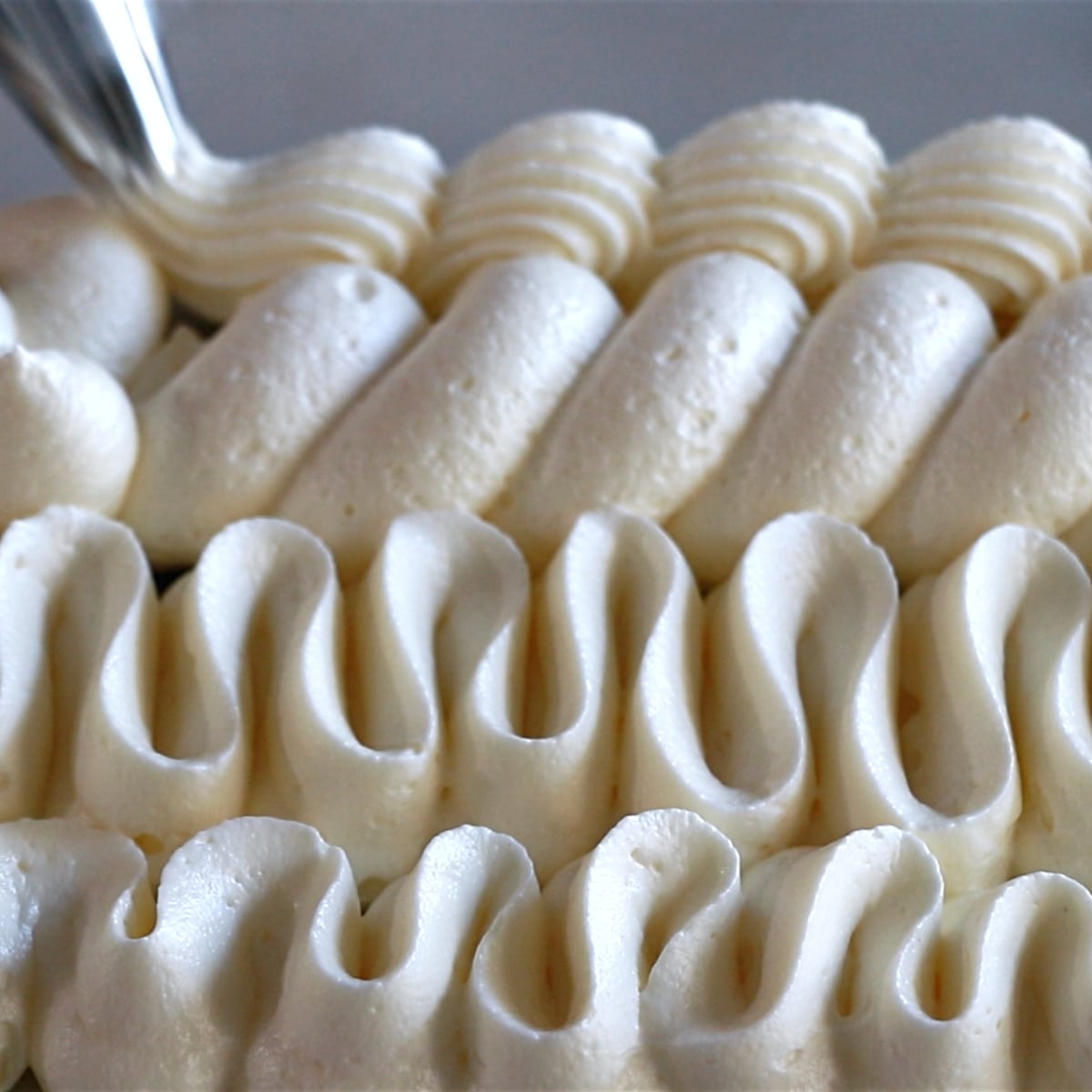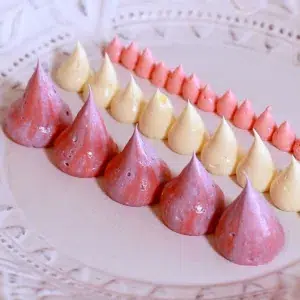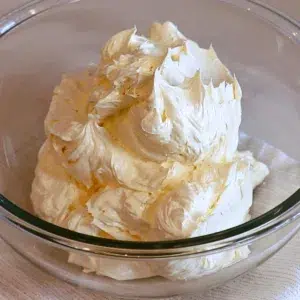Discover the 8 types of buttercream frosting and how they are different to find out which one suits your dessert needs!

Jump to:
- What Is Buttercream?
- 1. American Buttercream (AKA. Basic Buttercream)
- 2. Italian Buttercream (AKA. Italian Meringue Buttercream)
- 3. Swiss Buttercream (AKA. Swiss Meringue Buttercream)
- 4. French Buttercream (AKA. Pâte à Bombe Buttercream)
- 5. German Buttercream (AKA. Creme Mousseline)
- 6. Russian Buttercream (AKA. Condensed Milk Buttercream)
- 7. English Buttercream (AKA. Anglaise buttercream)
- 8. Ermine Buttercream (AKA. boiled-milk frosting or flour buttercream)
- My Favorite Types of Buttercream
- How To Flavor Buttercream
- How To Color Buttercream
- How To Store Buttercream
American buttercream, Italian buttercream, Swiss buttercream.....
There are so many types of buttercream in the world.
... and "How are they all different?"
This is the question I get frequently.
So I decided to share it with illustrations as simply and clearly as possible.
I hope this post clears up some of your questions about buttercream so you can decide which buttercream you should use for your special dessert.
Let's go!💪🏻
What Is Buttercream?
Buttercream is made by combining whipped buttercream and "something sweet".
In other words, buttercream needs to be:
- Made with whipped butter as the main ingredients
- Sweet

It might sound too simple, right? It's just the "something sweet" varies for each buttercream. Let's take a closer look!
Here is the list of the eight different types of buttercream frosting and how they are made:
1. American Buttercream (AKA. Basic Buttercream)
Butter + Powdered sugar + (Additional ingredients: milk, heavy cream, salt, extracts, colorings, etc.) = American buttercream frosting

This is the most simple type of buttercream. There is no need to heat ingredients or require a list of preparations. Simply whip confectioners' sugar and butter, and that is it!
You'll love American buttercream if you are looking for:
- Super easy buttercream
- Buttercream that colors well with food coloring
- Stiff buttercream
The cons of American buttercream:
- Very sweet
- It feels slightly grainy due to the powdered sugar
- It dries quickly in the air.
- It tends to get very firm in the fridge.
2. Italian Buttercream (AKA. Italian Meringue Buttercream)
Butter + Italian meringue + (Additional ingredients) = Italian meringue buttercream frosting

Italian meringue is made by adding hot sugar syrup to meringue. It is fluffy and stable, which makes fluffy and stable Italian meringue buttercream!
You'll love Italian buttercream if you are looking for:
- Not overly sweet buttercream
- Stiff and stable buttercream
- Light and airy buttercream
The cons of Italian buttercream:
- A little bit time-consuming
- The food coloring looks more pastel. (You may not like it if you want a super bright color.)
3. Swiss Buttercream (AKA. Swiss Meringue Buttercream)
Butter + Swiss meringue + (Additional ingredients) = Swiss Buttercream Frosting

Swiss meringue is made by heating egg whites and sugar together in a double boiler and whipping them after that. Swiss meringue is stiffer than Italian meringue since it's cooked at a higher temperature.
Swiss buttercream is very stiff and stable yet light, thanks to the meringue.
You'll love Swiss buttercream if you are looking for:
- Not overly sweet buttercream
- Very stiff and stable buttercream for piping intricate designs
- Light and airy buttercream
The cons of Swiss buttercream:
- A little bit time-consuming
- Whisking the egg whites while heating them can be a bit exhausting
- The food coloring looks more pastel. (You may not like it if you want a super bright color.)
4. French Buttercream (AKA. Pâte à Bombe Buttercream)
Butter + Pâte à bombe (a mixture of whipped yolks and hot syrup) + (Additional ingredients) = French Buttercream Frosting

Pâte à bombe is fluffy egg yolk forms, made by combining whipped egg yolks and hot sugar syrup. It is often used to make French desserts, such as chocolate mousse.
French buttercream is rich in flavor because of the Pâte à bombe. I often like to use it as a macaron filling. It's stiff and stable, although it's not as thick as meringue-based buttercream.
You'll love French buttercream if you are looking for:
- Not overly sweet buttercream
- Rich buttercream
- Great way to use up egg yolks
The cons of French buttercream:
- A little bit time-consuming
- The buttercream is a little bit pale yellow due to the yolks.
- It is stiff and stable but not as much as meringue-based buttercream.
5. German Buttercream (AKA. Creme Mousseline)
Butter + Pastry cream + (Additional ingredients) = German Buttercream Frosting

Pastry cream is used in a variety of desserts, such as cream puffs, eclairs, fresh fruit tarts, custard pies, fraisier cake, Boston cream pie, etc.
German buttercream is rich and flavorful and not too thick. It's often used for classic desserts, such as Fraisier cake.
You'll love German buttercream if you are looking for:
- Not overly sweet buttercream
- Rich buttercream
- Great way to use up egg yolks
The cons of German buttercream:
- Time-consuming
- The buttercream is a little bit pale yellow due to the yolks.
- Contains flour in the pastry cream. Use cornstarch instead if you want to make it gluten-free.
6. Russian Buttercream (AKA. Condensed Milk Buttercream)
Butter + Condensed milk + (Additional ingredients) = Russian Buttercream Frosting

There is sweetened and unsweetened condensed milk. Be sure to use sweetened condensed milk.
Russian buttercream is smooth, shiny, and very easy to make.
You'll love Russian buttercream if you are looking for:
- Easy buttercream
- Egg-free buttercream
The cons of Russian buttercream:
- Not entirely from scratch (unless you make the condensed milk!)
- Very rich in dairy (can be a con or pro!)
7. English Buttercream (AKA. Anglaise buttercream)
Butter + Anglaise sauce + (Additional ingredients) = English Buttercream Frosting

Anglaise sauce is often used as an ice cream base and a sauce for plated desserts. I use coffee English buttercream for my opera cake to create rich yet not too stiff buttercream.
You'll love English buttercream if you are looking for:
- Not overly stiff buttercream (can be a pro if it's what you are looking for)
- Not overly sweet
- A way to use leftover egg yolks
The cons of English buttercream:
- Time-consuming
- Very rich in dairy (can be a con or pro!)
- looser texture
8. Ermine Buttercream (AKA. boiled-milk frosting or flour buttercream)
Butter + Cooked milk & flour paste + (Additional ingredients) = Ermine frosting

Ermine buttercream does not contain eggs and uses flour instead to thicken the milk. It is creamy, smooth, oftentimes, not overly sweet.
You'll love Ermine buttercream if you are looking for:
- Egg-free buttercream
- Stable buttercream - stays more stable in warmer weather.
The cons of Ermine buttercream:
- Requires the heating process
- Contains flour
... And that is it!
There are some other buttercreams in smaller categories, but I am stopping here today so it won't look too confusing.
These 8 types of buttercream are more than enough to recreate any type of cake and pastry.👩🏻🍳❤️
My Favorite Types of Buttercream
As just one guideline, I will share my current favorite buttercream under each category below.
This is solely my preference, but I hope this helps you to decide which one you want to try for your dessert next time.
1. For frosting cakes and cupcakes
- Swiss meringue buttercream - It is a very stiff and stable buttercream that is perfect for small to very large cakes, such as wedding cakes. You can create beautiful piped designs with it, like I did with a pink vintage cake.
- Italian meringue buttercream - It is not as stiff and stable as Swiss buttercream but still a great choice as frosting cakes. I often use it when frosting cupcakes.
2. For piping intricate designs
- Swiss meringue buttercream - The stiff buttercream is perfect for complex designs, such as flower buttercream, and detailed cake decoration. I am sharing 24 ways to pipe with round tips using this Swiss buttercream.
3. For the taste
- Italian meringue buttercream - I love the fluffy and airy texture. It is not overly sweet and silky smooth.
- French buttercream - It is my go-to choice when I want to add richness. It is not overly sweet and smooth.
But I also love Swiss buttercream and German buttercream.. it is a hard to pick one really! It really depends on what flavor and taste you want to pair with your cakes and desserts.
4. When I want bright colors in buttercream
- American buttercream - It is my go-to buttercream whenever I want the colors to be very bright for the design theme, such as my 24 Halloween cupcakes.
5. Overall Pick
- Swiss meringue buttercream - When I need buttercream, I often want it to be very stiff and stable with intricate designs or to make sure the cake stays in shape. Swiss buttercream is the most stiff buttercream yet light and not overly sweet, which is ideal for a wide range of desserts and cakes.
Each buttercream has different characters, as listed above, so pick your ideal one that suits your specific cake and dessert!
How To Flavor Buttercream
You can add flavor to any type of buttercream and create different buttercreams. Here are some ideas for the flavors!
- Cream cheese to make cream cheese frosting for red velvet cake and red velvet cupcakes
- Flavor extract, such as vanilla extract, to make a vanilla cake and cupcakes
- Lemon curd to make lemon buttercream, to create lemon desserts, such as lemon cakes and lemon macarons.
- Melted chocolate or cocoa powder to make chocolate buttercream for chocolate cake and cupcakes
- Matcha powder to make matcha buttercream
- Caramel sauce to make caramel buttercream
- Jam, such as strawberry jam, to make strawberry buttercream
- Nut paste, such as pistachio paste, to make pistachio buttercream

How To Color Buttercream
To color the buttercream, I recommend using gel paste food coloring instead of liquid colorings to prevent it from getting too loose. The colors get more vivid with them as well.
How To Store Buttercream
Store buttercream in an airtight container. Shelf life is different for each buttercream. Follow the guidance for each recipe. I recommend storing it in the fridge or freezer if you are not using it within the day. Some buttercreams do better than others at room temperature, but you can keep them fresher by storing them in a cooler place.
All the buttercream in this post can be stored in the freezer. Thaw the frozen buttercream overnight in the fridge. Leave the chilled buttercream at room temperature to soften it again.





Leave a Reply